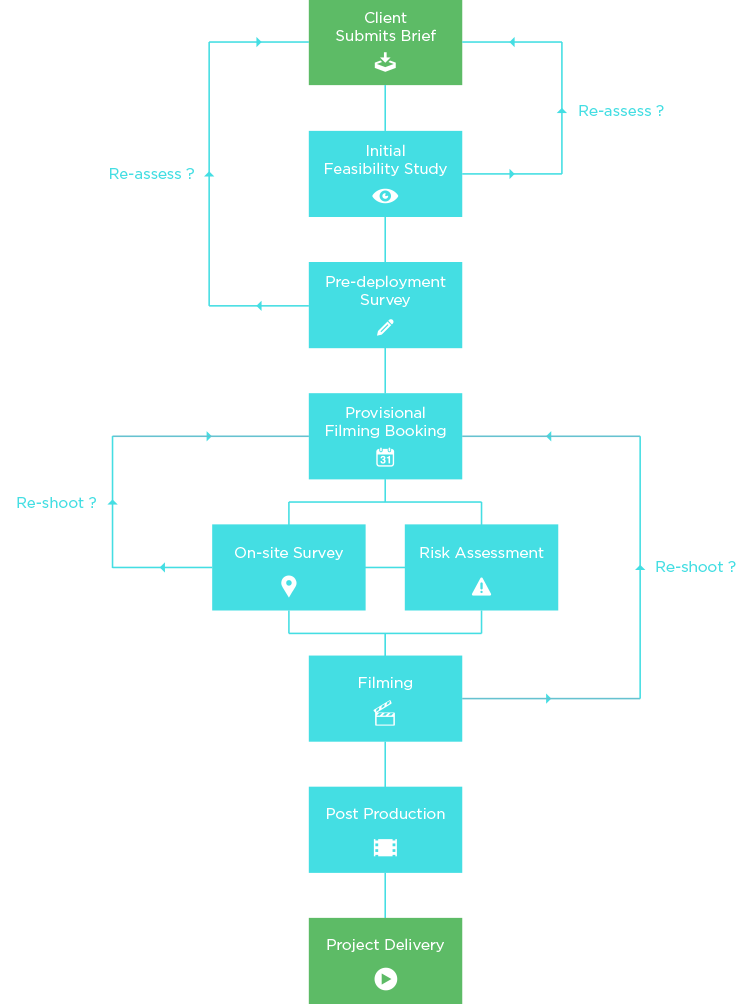
Process description and project terms
Client Submits Brief
A simple brief is initially required detailing; contact details (of all parties involved), required assets, desired location/s, intended usage, timescale, dependencies.
Initial Feasibility Study
This stage is simply a basic review of the supplied brief to assess the feasibility of the intended project and it’s requirements.
Pre-deployment Survey
A pre-deployment survey must be carried out as part of the planning stage. This is a mandatory process defined by the company’s operations manual which was submitted to the CAA to enable legal permissions to operate as a commercial aerial assets supplier.
This process takes the form of an internally used document (copies can be supplied on request) and will detail the following:
- Client information1
- Proposed date / time of operation
- Location details and access
- Geographical information
- Asset acquisition details
- Airspace; classification, restrictions, hazards
- Air proximity users
- Location; permission2, restrictions, sensitivities
- Terrain, ground hazards, public access
- Risk identification and reduction
- Meteorological information
- Notifications to authorities
- Pre-deployment risk assessment
If anything is flagged-up during this research, the brief may need to be reviewed. For example, the desired location may be within restricted airspace, or the land owner’s permission is not available. The client will be consulted to resolve any such issues before proceeding.
1. Any collected data will strictly adhere to this Privacy Policy.
2. The landowner will be asked to sign a Location Agreement.
Nb. Council owned land, or locations, may require permits. Any such fees will be payable by the client.
Provisional Filming Booking
If everything checks out thus far, a provisional filming date / time will be booked. Aerial operations are heavily dependent on optimal weather conditions, so dates / times can often need re-scheduling. It should be noted that there will be no additional cost for re-scheduled filming times.
On-site Survey
When the crew arrives at the location, a detailed on-site survey will be carried out. This is a mandatory process defined by the company’s operations manual which was submitted to the CAA to enable legal permissions to operate as a commercial ariel assets supplier.
This process takes the form of an internally used document and will detail the following:
- Meteorological data
- Optimal capture information
- Various checks to identify hazards
- Various checks to ensure safety protocol
- Contact details of relevant authorities
Even with the best planning, circumstances may arise which will mean filming cannot take place. In these situations, a re-shoot will be arranged. It should be noted that there will be no additional cost for re-shooting due to technical or circumstantial events.
Risk Assessment
When the crew arrives at the location, a detailed risk assessment will be carried out. This is a mandatory process defined by the company’s operations manual which was submitted to the CAA to enable legal permissions to operate as a commercial ariel assets supplier.
The assessment may deem the operation to be unsafe, in which case a re-shoot will be arranged. It should be noted that there will be no additional cost for re-shooting due to circumstantially high risk situations.
Filming
If everything checks out thus far, filming may proceed as planned.
Any technical problems which may affect the quality of the required assets may mean a re-shoot will need to be arranged. It should be noted that there will be no additional cost for re-shooting due to technical or circumstantial events.
Post Production
Unless instructed otherwise, all obtained assets will undertake the necessary post production processes to create the usable content.
Project Delivery
The final assets are presented and delivered to the client.
Insurance
The company is covered by a public liability insurance policy from Coverdrone Insurance (underwritten by Lloyd’s UK) which specifically covers aerial photography / videography. The level of cover is up to £5m and includes operation in the following high risk premises; watercraft, docks, harbours, boatyards or inland waterways.